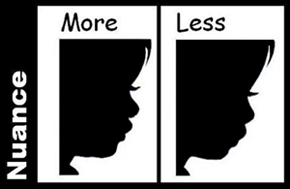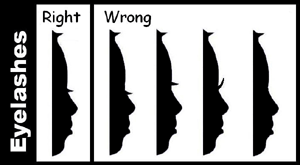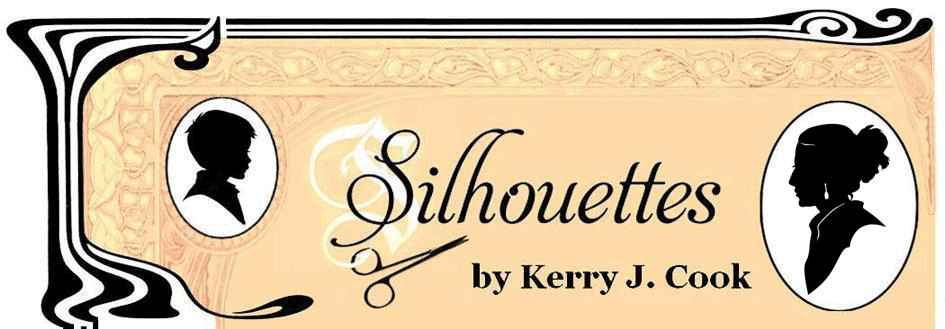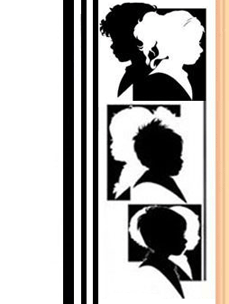|
What is Quality?
by Kerry J. Cook
A
Vanishing Art
Don't Fall for Hype
What to Look For:
Style: Knowing What
You Like
Edouart on the Subject of Style
Art
vs. Gimmick
Think
Twice Before Ordering Custom Profiles Online
A Vanishing Art
Thirty years ago there were many
more silhouette artists working, and more good artists
working. Competition improved the quality of the art. And
because the public had a wider exposure to top quality
silhouettes, more people knew what good silhouettes should look
like.
Most people today know
silhouettes only from childhood, and the concept of hand artwork
seems to be fading from our culture. It's increasingly common
for people to assume that silhouettes must go through some
process of projection, or some digital or photographic process.
So what should you look for in a silhouette? How do you choose
an artist?
Don't Fall for Hype
It is important to
recognize that silhouettes have held a centuries-long
association with carnivals and traveling shows, and consequently
have been cut by all manner of showmen, Yankee peddlers and
other rascals. Two hundred years ago there were silhouettists
who traveled from town to town with automatons -- mechanical
puppets dressed in flowing robes -- and these artists assured
the local townspeople that their likenesses would be made by the
mechanical figure itself. By magic. In reality, the
machine's operator hid behind a peep-hole, and moved the
automaton's hand by means of a pantograph.
Today's hype is tame by
comparison. No more fantastical silhouette-drawing puppets.
Today we just have wild internet claims about being "the best,"
or " the fastest," or "the premier artist" -- the same boasts
silhouettists have made for centuries.
Speed doesn't matter. Not
when the difference between fastest and slowest is measured in
seconds, or at most a couple of minutes. And it doesn't matter
which famous clients an artist claims, or what magazines or
television shows they brag about. It doesn't matter how long
they've been cutting silhouettes, or at what age they began.
What matters is the art.
Look at the art. The art speaks for itself.
What to Look For
The litmus test for any
silhouette is simple: Does it look like its subject?
But how can you know --
before you buy -- whether an artist's samples resemble the real
people who posed? Many unlikely looking silhouettes actually do
look like real people, and many perfectly cute silhouettes are
so generic they could represent almost anyone of the right age
and gender.
Even if you don't have any
way to compare silhouettes with their subjects, there's a lot
you can learn by looking at samples -- once you know what to
look for:
-
First and most
importantly, the best silhouettes have soul.
When you examine samples of an artist's work, does each
silhouette seem to have a distinct personality? Or are
they all similar? Too many "generic" looking
silhouettes is the mark of a poor artist, or an amateur.
-
Consider the
variety of faces an artist displays. Do all the
noses look alike? Does every child have a button nose?
Are all the chins the same? All the foreheads?
In the case of less skilled artists, and formula cutters,
you sometimes see the same profile repeated again and again,
dressed up with different hairstyles and accessories.
Does the artist show samples representative of diverse types?
Babies? Adults? Different races? Is it
easy to tell the ages of the subjects? You might make
some allowances, recognizing that the sample selection may
not fully represent the range of an artist's work. But
nevertheless, variety and specificity should be apparent.



-
Look at the quality
of the lines. Are the edges clean? Look
closely at the forehead, the curve of the chin, the tip of
the nose, and the finishing cut at the bottom. If you
can see corners and jags that don't belong there, this means
either that the artist was unskilled, or perhaps that a
skilled artist was cutting too fast. On the finishing
cut this isn't a major problem, and jerky finishing cuts
turn up sometimes even in top quality work, such as first
rate vintage silhouettes. But choppy lines in the face
are a big problem, and can also be a problem in the hair.
Sometimes the paper can slip on back copies, compromising the
smooth line, but those should not be the images an artist
chooses as samples. Be aware that what looks like a
jerky cut in an online digital image may just be an artifact
of the digital process/screen resolution, but by looking carefully
you should be able to tell the difference. In general,
silhouettes shouldn't have choppy lines -- unless
appropriate to the likeness, or as a clear affectation of
style.
-
Facial features
should be distinct. Still looking at the edges, do
all the features seem to flow together as if molded too
hastily out of clay? Look closely at the place where
the lips meet. If the lips are fully closed, that
should come to a sharp angle. Look also at the high
point of each lip, and at the juncture under the nose.
These places sometimes also show relatively sharp angles,
depending on the face. Any individual silhouette may
be legitimately without sharp angles. However, if
there are no sharp angles to be found in any of an
artist's samples, if all the features slide together in
rolling curves, that usually indicates a problem with
likenesses.
-
A good artist will
demonstrate a nuanced specificity of line. Each
individual facial feature will, if you study it closely,
turn out to be made up of a complex series of planes and
curves. Nothing should look too "regular" in shape.
There should be no predictable, geometric looking contours.
Nothing that looks too much like a segment cut out of a
circle or ellipse -- especially not if you see the same
shape repeated in multiple silhouettes.

-
Consider the
silhouettes in their entirety. Are the head shapes
realistic? Do the bottom halves of the faces
coordinate with the top halves in a way that makes sense?
Are the postures natural? Look at the back of the neck
and the shoulders -- are these in natural positions, or do
they seem stiff or forced?
-
Examine the
eyelashes. Eyelashes are important, because without
them silhouettes look blind. Are all the eyelashes in
the right place? Eyelashes which are too low or too
high can distort the whole appearance of a silhouette, and
warp the likeness. Often a silhouette which is
unflattering, a silhouette which looks subtly wrong but
you're not sure why, turns out to have a poorly placed
eyelash. Ideally, eyelashes should have a naturalistic
shape, which varies with each likeness, and should by their
direction -- by looking up, or down -- help convey
personality and mood.

-
What size is the
artist working? Silhouettes should be small, no
more than about two inches from the tip of the chin to the
top of the forehead, and usually smaller. There are
compelling reasons for this:
-
First, because it
is a matter of long tradition, going all the way back in
silhouette history. Silhouettes have their roots
in the practice of painted miniatures.
-
Second, for the
very practical and important reason that an artist who
freehand cuts larger than sight-size (the two-inch rule)
has much less control over the likeness. The
quality of his work will suffer as a result.
-
Third, and most
importantly, silhouettes must be small for reasons of
aesthetics. Just consider: Silhouettes have only
one line -- the outline -- with which to tell a story.
If the image is small, the silhouetted shape looks
intricate and intriguing. It draws you in, and makes
you want to look closer. At larger sizes, the lack
of surface detail becomes too glaring, making very large
silhouettes appear unsophisticated, and often soulless.
Style: Knowing What You
Like
Some artists cut a clean,
slightly stylized line. Others specialize in intricate
detail. Some make lots of in-cuts into the black area of
the silhouette, to show surface details of hair and clothing.
Others prefer to tell the story as much as possible with the
outline alone -- the one pure line of contour, the true
silhouette.
All these styles can be
done well or badly, and are matters of personal taste.
Even though each artist
has a unique style, a good artist should usually be able to
match or compliment the style of old silhouettes that have been
passed down in your family. (Depending on the request, and
the time and difficulty involved, this may require a special
commission.)
But someone who knows how
to cut a very detailed line well, can easily cut a more
stylized line. Someone who knows how to cut a stylized
line well, can always add detail.
Edouart on the Subject
of Style
Writing in 1835, Augustin
Edouart, arguably the greatest silhouette artist who ever lived, expressed some very definite -- and
somewhat petulant -- opinions about style.
In his time gilded
silhouettes were all the rage. These silhouettes, cut from
black paper, were decorated with colorfully painted details,
which Edouart described as "possess[ing] sometimes all the
various colors of the rainbow..."
|
"With gold hair drawn on them,
coral ear-rings, blue necklaces, white frills, green
dress and yellow waist band, etc., is it not
ridiculous to see such harlequinades?... I
cannot understand how persons can have so bad and I
may say, a childish taste! Very
often these Likenesses are brought to me to have
copies made of them; and it is with the greatest
trouble I am able to make them understand, that it is
quite unnatural; and that taking a Silhouette, which
is the fac-simile of a shade, it is unnecessary for
its effect to bedizen it with colors...
"It must be observed that the
representation of a shade, can only be executed by
an outline; that all that is in dress, is only
perceived by the outward delineation; consequently,
all other inward additions, produce a contrary
effect of the appearance of a shade. Here it
may be said that everyone has not the same
taste..."
Monsieur Edouart, A
Treatise on Silhouette Likenesses, 1835
|
Art vs. Gimmick
-
Silhouettes are traditionally cut out of black paper,
mounted on white. You can easily find online
craftspeople offering all sorts of gimmicks -- crude
profiles in unusual color combinations, machine-cut
scrapbooking images from digital templates, selections of
"one-size-fits-all" generic profiles intended to represent
you family members, and all sorts of other "modern"
affectations.
It's important to understand that if what you really want is
a good silhouette cut out of green paper, a real artist can
easily do it for you.
But if what you want is a good silhouette, the
hobbyist or craftsperson who relies on gimmicks won't be
able to help.
-
Beware of artists who emphasize speed over quality. If
speed is what they care about most, this will certainly be
reflected in the quality of their work. Will you
display a silhouette on the wall of your home, and pass it
down as an heirloom to your children, because it was cut in
less than two minutes? Or is it more important that
the likeness is clear and evocative, and the lines are
beautiful?
-
A
real artist should invite people to stand behind them when
they work. One fairly recent "how-to" book actually
offers detailed instruction for pretending to cut
silhouettes freehand, while in reality covertly employing
pre-made templates. Founded on the very mistaken
idea that all faces look pretty much alike anyway, this sort
of trickery depends on not letting anyone watch from
behind.
-
Silhouette artists look at the face, not at the shadow of the
face. Remember that in daily life shadows are almost
always distorted, and unclear. Any sales pitch about some
special talent for seeing shadows is just that -- a
pitchman's ploy.
Think
Twice Before Ordering Custom Profiles Online
All silhouette artists occasionally work from
photos. Sometimes there's no choice. But it's wise
to think twice before commissioning a silhouette from someone
who seems to prefer working from photos. The real joy and
art of silhouettes comes in working from life, not from photos.
Silhouettes cut from life have more personality.
A silhouette based on a photo can never be better
than the photo. The artist is limited by the photo. For one
thing, there is no choice of expression. Perhaps the photo is
not in true profile. Or, very commonly, the chin or jaw is not
in a natural position, distorting the likeness -- but the artist
won't have any way to know that. A chin held too high in a
photograph makes for a very unflattering silhouette, whereas in
person an artist can easily say, "look down a little lower."
Especially with very young children, whose faces
are so incredibly mobile, the artist's job is to correctly catch
the right lines to tell the story. A camera can't do this
effectively, because cameras see only tiny "slices" of time.
With very young and wiggly children it's quite common that there
is never a single instant when the whole face is in the best
expression, all at once. Sometimes even their noses change
shape, depending on the position of their lips. But the artist,
who watches the child in motion, can patiently compose features
one at a time, in order to create the most charming likeness.
A silhouette done from life also allows the
artist to select telling details which may not be apparent in
photographs -- for example, a single wispy curl at the back of
the neck of a very young baby. The camera may not show this
clearly, perhaps because of lighting, or because the curl twists
too much to the side. But the artist can choose to include it.
With a few snips of the scissors -- and a live
model in the chair -- an artist can turn a pigtail into a
pony-tail, in order to make the silhouette more appealing. In
making these sorts of artistic decisions, the outcome is always
better when the artist has the opportunity to see the real hair
from different angles.
Whenever possible, it is always better to have
silhouettes done from life.
|





